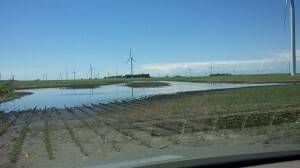Water Has the Power to Give and to Take
 June 2014 was the wettest on record for many portions of the Midwest, and my farm is no exception. Soils have been saturated for a good portion of the past month, making it a challenge to control weeds and apply plants foods (aka fertilizer).
June 2014 was the wettest on record for many portions of the Midwest, and my farm is no exception. Soils have been saturated for a good portion of the past month, making it a challenge to control weeds and apply plants foods (aka fertilizer).
Plants need a well-balanced diet for optimal performance, so that’s why we “spoon feed” our corn by side dressing nitrogen. Fortunately, I finished applying nitrogen and the next day a 3-inch rain fell! Usually, getting “rained out” isn’t a big deal because the fields dry out and you go back taking care of your crops. This season’s series of rain events has made it difficult to walk through the fields to see what crop care is needed.
Heavy rains have caused damage to everything from crops and buildings to the soil. Erosion is a concern, but there is a great deal of misunderstanding by the general public. I overhear comments like, “Those d@!# farmers should do a better job of taking care of the soil. They’re letting it all wash away with all that fertilizer, polluting our water.”
Sometimes there is little that can be done. I have watched water ravage my crops during the past couple weeks with awesome power! When it rains three or more inches in just a couple of hours, that water must go somewhere because it cannot soak into the soil when it rains that fast and hard. The water builds force as it through the fields. It flows deeper and faster – and nothing can stop it.
Such force of nature is evident as videos surface of bridges and roads being washed away. Many town’s storm sewers have been so overwhelmed that raw sewage is dumping straight into rivers, which is something farmers cannot do. Isn’t it interesting the same standards don’t apply to farmers and cities? There is a zero tolerance for livestock manure, so producers must build structures large enough to contain the biggest rain.
Water improvements are occurring in Iowa. In an article published yesterday by The Des Moines Register, farmer and writer Darcy Maulsby does a great job explaining these improvements being made by farmers in her area:
- Stream bank stabilization
- Livestock nutrient management
- Conservation farming
Conservation farming – buffer strips, waterways – and even tile help make my flat, mucky soil farmable, as well as contain big rains and keep top soil from washing off the fields. Many improvements have been made in the 50 years that I’ve been farming, and new ways are being developed all the time.
For example, we’re hearing more and more about using cover crops to help hold fertilizer where it is needed. Certain cover crops, with their huge root systems, make channels in the soil so more water seeps into the ground. Wetlands are being developed to filter out sediment, just like a coffee filter keeps grounds out of your morning cup of Joe. No till, made possible by biotechnology, has been a huge tool on my farm.
While these practices have made strides in the right direction, we understand that we must practice continual improvement. Iowa farmers are leading change because it’s the right thing to do!